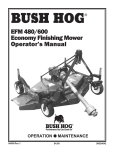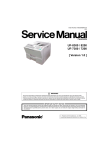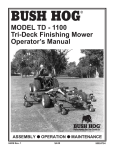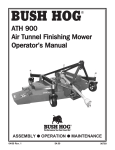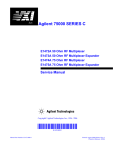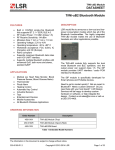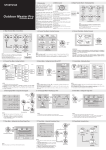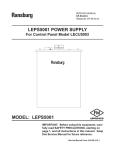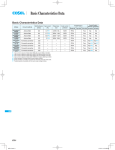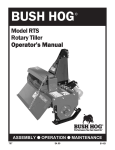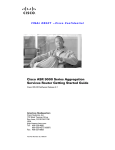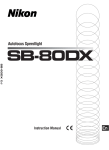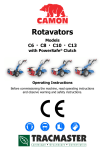Download Bush Hog 2315 Operator`s manual
Transcript
BUSH HOG ® 2315 FLEX-WING ROTARY CUTTER Operator’s Manual ASSEMBLY ● OPERATION ● MAINTENANCE 797 $4.00 Part No. 91885 CONGRATULATIONS! You have invested in the best implement of its type on the market today. The care you give your Bush Hog implement will greatly determine your satisfaction with its performance and its service life. We urge a careful study of this manual to provide you with a thorough understanding of your new implement before operating, as well as suggestions for operation and maintenance. If your manual should become lost or destroyed, Bush Hog will be glad to provide you with a new copy. Order from Bush Hog, P. O. Box 1039, Selma, Alabama 36702-1039. Most of our manuals can also be downloaded from our website at www.bushhog.com. As an authorized Bush Hog dealer, we stock genuine Bush Hog parts which are manufactured with the same precision and skill as our original equipment. Our trained service personnel are well informed on methods required to service Bush Hog equipment, and are ready and able to help you. Should you require additional information or assistance, please contact us. YOUR AUTHORIZED BUSH HOG DEALER BECAUSE BUSH HOG MAINTAINS AN ONGOING PROGRAM OF PRODUCT IMPROVEMENT, WE RESERVE THE RIGHT TO MAKE IMPROVEMENTS IN DESIGN OR CHANGES IN SPECIFICATIONS WITHOUT INCURRING ANY OBLIGATION TO INSTALL THEM ON UNITS PREVIOUSLY SOLD. BECAUSE OF THE POSSIBILITY THAT SOME PHOTOGRAPHS IN THIS MANUAL WERE TAKEN OF PROTOTYPE MODELS, PRODUCTION MODELS MAY VARY IN SOME DETAIL. IN ADDITION, SOME PHOTOGRAPHS MAY SHOW SHIELDS REMOVED FOR PURPOSES OF CLARITY. NEVER OPERATE THIS IMPLEMENT WITHOUT ALL SHIELDS IN PLACE. 2315 ROTARY CUTTER TABLE OF CONTENTS SECTION/PARA PAGE IV. MAINTENANCE ..................................10 4-1 Maintenance Check List ................10 4-2 Lubrication .....................................11 4-3 Blade Replacement .......................14 4-4 Blade Pan Removal .......................14 4-5 Blade Holder Assembly Removal and Installation................14 4-6 Slip Clutch Operational Check.......15 4-7 Slip Clutch Adjustment...................15 4-8 Troubleshooting .............................15 V. ASSEMBLY..........................................16 5-1 Model 2315 Assembly ...................16 Hydraulic Diagrams..............................21 Axle Arm Diagram................................23 Safety Decals.......................................24 Torque Specifications...........................25 SECTION/PARA PAGE Warranty.................................................2 Dealer Preparation Check List ...............3 Safety Precautions.................................4 Federal Laws and Regulations ..............5 I. INTRODUCTION & DESCRIPTION ......6 1-1 Introduction ......................................6 1-2 Description.......................................6 II. PREPARATION FOR USE.....................7 2-1 Attaching To Tractor ........................7 2-2 Optional Valve Mounting Bracket Installation ..........................7 2-3 Pitch Adjustment..............................8 2-4 Wing Adjustment..............................8 III.OPERATING INSTRUCTIONS ..............9 3-1 General Instructions.........................9 3-2 Transporting.....................................9 3-3 Operation .........................................9 RETAIL CUSTOMER’S RESPONSIBILITY UNDER THE BUSH HOG WARRANTY It is the Retail Customer and/or Operator’s responsibility to read the Operator’s Manual, to operate, lubricate, maintain and store the product in accordance with all instructions and safety procedures. Failure of the operator to read the Operator’s Manual is a misuse of this equipment. It is the Retail Customer and/or Operator’s responsibility to inspect the product and to have any part(s) repaired or replaced when continued operation would cause damage or excessive wear to other parts or cause a safety hazard. It is the Retail Customer’s responsibility to deliver the product to the authorized Bush Hog Dealer, from whom he purchased it, for service or replacement of defective parts which are covered by warranty. Repairs to be submitted for warranty consideration must be made within forty-five (45) days of failure. It is the Retail Customer’s responsibility for any cost incurred by the Dealer for traveling to or hauling of the product for the purpose of performing a warranty obligation or inspection. 1 BUSH HOG® LIMITED WARRANTY ✯✯✯✯✯✯✯✯✯✯✯✯✯✯✯✯✯✯✯✯✯✯✯✯✯✯✯✯✯✯✯ Bush Hog warrants to the original purchaser of any new Bush Hog equipment, purchased from an authorized Bush Hog dealer, that the equipment be free from defects in material and workmanship for a period of one (1) year for non-commercial, state, and municipalities’ use and ninety (90) days for commercial use from date of retail sale. The obligation of Bush Hog to the purchaser under this warranty is limited to the repair or replacement of defective parts. Replacement or repair parts installed in the equipment covered by this limited warranty are warranted for ninety (90) days from the date of purchase of such part or to the expiration of the applicable new equipment warranty period, whichever occurs later. Warranted parts shall be provided at no cost to the user at an authorized Bush Hog dealer during regular working hours. Bush Hog reserves the right to inspect any equipment or parts which are claimed to have been defective in material or workmanship. DISCLAIMER OF IMPLIED WARRANTIES & CONSEQUENTIAL DAMAGES Bush Hog’s obligation under this limited warranty, to the extent allowed by law, is in lieu of all warranties, implied or expressed, INCLUDING IMPLIED WARRANTIES OF MERCHANTABILITY AND FITNESS FOR A PARTICULAR PURPOSE and any liability for incidental and consequential damages with respect to the sale or use of the items warranted. Such incidental and consequential damages shall include but not be limited to: transportation charges other than normal freight charges; cost of installation other than cost approved by Bush Hog; duty; taxes; charges for normal service or adjustment; loss of crops or any other loss of income; rental of substitute equipment, expenses due to loss, damage, detention or delay in the delivery of equipment or parts resulting from acts beyond the control of Bush Hog. THIS LIMITED WARRANTY SHALL NOT APPLY: 1. To vendor items which carry their own warranties, such as engines, tires, and tubes. 2. If the unit has been subjected to misapplication, abuse, misuse, negligence, fire or other accident. 3. If parts not made or supplied by Bush Hog have been used in connection with the unit, if, in the sole judgement of Bush Hog such use affects its performance, stability or reliability. 4. If the unit has been altered or repaired outside of an authorized Bush Hog dealership in a manner which, in the sole judgement of Bush Hog, affects its performance, stability or reliability. 5. To normal maintenance service and normal replacement items such as gearbox lubricant, hydraulic fluid, worn blades, or to normal deterioration of such things as belts and exterior finish due to use or exposure. 6. To expendable or wear items such as teeth, chains, sprockets, belts, springs and any other items that in the company’s sole judgement is a wear item. NO EMPLOYEE OR REPRESENTATIVE OF BUSH HOG IS AUTHORIZED TO CHANGE THIS LIMITED WARRANTY IN ANY WAY OR GRANT ANY OTHER WARRANTY UNLESS SUCH CHANGE IS MADE IN WRITING AND SIGNED BY BUSH HOG’S SERVICE MANAGER, POST OFFICE BOX 1039, SELMA, ALABAMA 36702-1039. ✯✯✯✯✯✯✯✯✯✯✯✯✯✯✯✯✯✯✯✯✯✯✯✯✯✯✯✯✯✯✯ Record the model number, serial number and date purchased. This information will be helpful to your dealer if parts or service are required. MODEL NUMBER MAKE CERTAIN THE WARRANTY REGISTRATION CARD HAS BEEN FILED WITH BUSH HOG/ SELMA, ALABAMA SERIAL NUMBER DATE OF RETAIL SALE 2 DEALER PREPARATION CHECK LIST 2315 ROTARY CUTTER BEFORE DELIVERING MACHINE — The following check list should be completed. Use the Operator’s Manual as a guide. ❒ ❒ ❒ ❒ ❒ ❒ ❒ ❒ ❒ ❒ 1. Assembly completed. 2. Gearbox filled with oil. 3. All fittings lubricated. 4. All shields in place and in good condition. 5. All fasteners torqued to specifications given in Torque Chart. 6. Slip clutches have been checked for proper operation. 7. All decals in place and readable. (See decal page.) 8. Overall condition good (i.e. paint, welds) 9. Operators manual has been delivered to owner and he has been instructed on the safe and proper use of the cutter. 10. Purchaser or dealer elects to delete deflectors. (front belting, rear bands, front and rear chains) Explanation: ❒ 11. Purchaser or dealer elects to delete tow chain. Explanation: WARNING For Non-Agricultural use, OSHA, ASAE, SAE and ANSI standards require the use of Chain Guards or other protective guards at all times. Bush Hog strongly recommends the use of such guards for Agricultural uses as well, to reduce the risk of property damage, serious bodily injury or even death from objects thrown out by or from contact with the cutting blades. Dealer’s Signature Purchaser’s Signature THIS CHECKLIST TO REMAIN IN OWNER’S MANUAL It is the responsibility of the dealer to complete the procedures listed above before delivery of this implement to the customer. 3 IMPORTANT SAFETY PRECAUTIONS This symbol is used to call attention to safety precautions that should be followed by the operator to avoid accidents. When you see this symbol, carefully read the message that follows and heed its advice. Failure to comply with safety precautions could result in serious bodily injury. In addition to the design and configuration of equipment, hazard control and accident prevention are dependent upon the awareness, concern, prudence and proper training of personnel in the operation, transport, maintenance and storage of equipment. Lack of attention to safety can result in accident, personal injury, reduction of efficiency and worst of all—loss of life. Watch for safety hazards and correct deficiencies promptly. Use the following safety precautions as a general guide to safe operations when using this machine. Additional safety precautions are used throughout this manual for specific operating and maintenance procedures. Read this manual and review the safety precautions often until you know the limitations. 1. Read the Operator’s Manual. Failure to read the Operator’s Manual is considered a misuse of this equipment. 2. Become familiar with all the machine’s controls and all the caution, warning and danger decals affixed to the machine before attempting to start or operate. 3. Before starting or operating the machine, make a walk around inspection and check for obvious defects such as loose mounting bolts and damaged components. Correct any deficiency before starting. 4. Do not allow children to operate the cutter. Do not allow adults to operate it without proper instruction. 5. Do not carry passengers. 6. Keep the area of operation clear of all persons, particularly small children and pets. The operator should cease mowing whenever anyone comes within the operating area. 7. Clear the work area of objects which might be picked up and thrown. 8. Use a piece of cardboard or wood rather than hands to search for hydraulic leaks. Escaping hydraulic oil under pressure can penetrate skin. If fluid is injected into the skin, it must be surgically removed within a few hours by a doctor familiar with this form of injury or gangrene may result. 9. Do not operate without all guards and shields in place and in good condition. 10. Lower implement to ground, stop tractor engine, apply parking brake, and allow blades to completely stop before leaving the tractor. 11. Keep hands and feet away from blades. 12. This cutter is not to be operated along highways or in any area where people may be present unless all sides of the unit are enclosed by permanent bands, safety chains or other factory approved safety shields that are in good repair. 13. Wear personal protective equipment such as, but not limited to, protection for eyes, ears, feet, hands and head when operating or repairing the equipment. Do not wear loose clothing or jewelry that may catch on equipment moving parts. 14. When performing adjustments or maintenance on the cutter, first lower it to the ground or block it securely at a workable height. 15. Never stand between tractor and cutter while tractor is being backed to the cutter hitch. 16. Reduce speed when transporting cutter to avoid bouncing and momentary loss of steering. 17. Use tractor flashing warning lights, day or night, when transporting cutter on road or highways unless prohibited by law. 18. Stand clear of wing(s) when raising or lowering. 19. Purge air from hydraulic system before attempting to raise or lower wings. 20. In the event that someone other than yourself will operate this equipment we firmly suggest that all SAFETY references be discussed prior to operation. 21. It is recommended that tractor be equipped with Rollover Protective System (ROPS) enclosed cab, and a seat belt. 4 IMPORTANT FEDERAL LAWS AND REGULATIONS* CONCERNING EMPLOYERS, EMPLOYEES AND OPERATIONS. *(This section is intended to explain in broad terms the concept and effect of the following federal laws and regulations. It is not intended as a legal interpretation of the laws and should not be considered as such). U.S. Public Law 91-596 (The Williams-Steiger Occupational and Health Act of 1970) OSHA This Act Seeks: “...to assure so far as possible every working man and woman in the nation safe and healthful working conditions and to preserve our human resources...” DUTIES Sec. 5 (a) Each employer— (1) shall furnish to each of his employees employment and a place of employment which are free from recognized hazards that are causing or are likely to cause death or serious physical harm to his employees; (2) shall comply with occupational safety and health standards promulgated under this Act. (b) Each employee shall comply with occupational safety and health standards and all rules, regulations and orders issued pursuant to this Act which are applicable to his own actions and conduct. OSHA Regulations Current OSHA regulations state in part: “At the time of initial assignment and at least annually thereafter, the employer shall instruct every employee in the safe operation and servicing of all equipment with which the employee is, or will be involved.” These will include (but are not limited to) instructions to: Keep all guards in place when the machine is in operation; Permit no riders on equipment; Stop engine, disconnect the power source, and wait for all machine movement to stop before servicing, adjusting, cleaning or unclogging the equipment, except where the machine must be running to be properly serviced or maintained, in which case the employer shall instruct employees as to all steps and procedures which are necessary to safely service or maintain the equipment. Make sure everyone is clear of machinery before starting the engine, engaging power, or operating the machine. EMPLOYEE TRACTOR OPERATING INSTRUCTIONS: 1. Securely fasten your seat belt if the tractor has a ROPS. 5. Watch where you are going, especially at row ends, on roads, and around trees. 2. Where possible, avoid operating the tractor near ditches, embankments, and holes. 6. Do not permit others to ride. 7. Operate the tractor smoothly - no jerky turns, starts, or stops. 3. Reduce speed when turning, crossing slopes, and on rough, slick, or muddy surfaces. 8. Hitch only to the drawbar and hitch points recommended by tractor manufacturers. 4. Stay off slopes too steep for safe operation. 9. When tractor is stopped, set brakes securely and use park lock if available. Child Labor Under 16 Years Old Some regulations specify that no one under the age of 16 may operate power machinery. It is your responsibility to know what these regulations are in your own area or situation. (Refer to U.S. Dept. of Labor, Employment Standard Administration, Wage & Home Division, Child Labor Bulletin #102.) 5 SECTION I INTRODUCTION AND DESCRIPTION Figure 1-1 Wing Cylinder Center Gearbox Shield Height Adjustment Cylinder Hose Holder Rod Driveline Retainer Axle Axle Arm Pillow Block Shield U-Joint Tongue Clevis Laminated Tire Wing Transport Lock Tongue Height Adjustment Jackstand Replaceable Wing Skid Discharge Shield (Chains) Wing Gearbox free-swinging uplift blades designed for light mowing. Free-swinging blades reduce the shock of impact when a stationary object is hit. Slip clutches are installed on each gearbox for additional protection. Front and rear center discharge shields are included as standard equipment. (Note: Dealer or purchaser may elect to delete the front shields at their option.) Machine specifications are given in Table 1-1. 1-1 INTRODUCTION We are pleased to have you as a Bush Hog customer. Your Model 2315 Flex Wing Rotary Cutter has been carefully designed to give maximum service with minimum down time. This manual is provided to give you the necessary operating and maintenance instructions for keeping your rotary cutter in top operating condition. Please read this manual thoroughly. Understand what each control is for and how to use it. Observe all safety precautions decaled on the machine and noted throughout the manual for safe operation of implement. If any assistance or additional information is needed, contact your authorized Bush Hog dealer. TABLE 1-1 SPECIFICATIONS Length . . . . . . . . . . . . . . . . . . . . . . . . . . . . . .183 in. Transport Width @ Tire in Transport . . . . . . .114 in. Transport Height . . . . . . . . . . . . . . . . . . . . . . . .81 in. Working Width . . . . . . . . . . . . . . .186 in. (472.4 cm) Cutting Height . . . . . . . . . . . .2-14 in. (5.1 - 35.6 cm) Cutting Capacity . . . . . . . . .Through 1.5 in. diameter Varies according to cutting conditions Blades . . . . . . . . .1/2 x 4 in. (12.7 x 101.6 mm) uplift Blade Overlap . . . . . . . . . . . . . . . . . .6 in. (15.2 cm) Blade Tip Speed . . . . .15,268 rpm @ 540 PTO rpm Gearbox Horsepower . . . . . . . . . . . Center - 125 hp Wing Gearbox - 80 hp Minimum Required Tractor Horsepower . . . . .50 hp Maximum Tractor Horsepower . . . . . . . . . . . .100 hp Working Angles w/Driveline Engagement . . . .60° up to 22° down NOTE All references made in this manual to right, left, front, rear, top or bottom is as viewed facing the direction of forward travel with implement properly attached to tractor. 1-2 DESCRIPTION The Model 2315 Rotary Cutter (Figure 1-1) consists of a center unit with two variable position wings together having a cutting width of 15 feet (4.5m). Wing operating angles and machine cutting height are independently controlled using hydraulic cylinders. A self-leveling linkage maintains a level cutter at all cutting heights. Power from the tractor PTO is split at the center gearbox and supplied to each of the blade gearboxes. Each blade gearbox has two Wing Angles . . . . . . . . . . . . . . . .90° up to 22° down Hitch . . . . . . . . . . . . . . . . . . . . .Clevis type standard 6 Figure 2-5 D. If wing(s) are not level (parallel to center section, disconnect one end of the wing adjustment linkage (Figure 2-5) and adjust shorter to raise the wing outside edge and longer to lower the wing outside edge. It may be necessary to use wing lift cylinder to relieve pressure from the linkage retaining pin. E. Reconnect linkage. Adjustable Link NOTE Prior to engaging PTO drive, all gearboxes should have the proper level of gear oil and all lubrication points should be serviced according to the “Maintenance Section.” SECTION III OPERATING INSTRUCTIONS 3-1 GENERAL SAFETY around self-leveling linkage rod. E. With tractor at idle speed, engage PTO drive. Only qualified people should operate this machine. Operator should wear hard hat, safety glasses and safety shoes. It is recommended that tractor be equipped with Rollover Protective System (ROPS) and a seat belt be used. Before beginning operation, clear work area of objects that may be picked up and thrown. Check for ditches, stumps, holes or other obstacles that could upset tractor or damage cutter. Always turn off tractor engine, set parking brake, and allow cutter blades to come to a complete stop before dismounting tractor. IMPORTANT DURING OPERATION THE HYDRAULIC VALVE WING LEVERS MUST BE LOCKED IN THE FLOAT POSITION TO AVOID DAMAGE TO THE CYLINDERS AND AXLES. WARNING IT IS HAZARDOUS TO OPERATE UNIT WITH WINGS RAISED ABOVE GROUND. DAMAGE CAN OCCUR TO WING DRIVELINE IF WINGS ARE OPERATED ABOVE 60°. 3-2 TRANSPORTING When implement is transported on road or highway, day or night, use tractor flashing warning lights unless prohibited by law. A slow moving vehicle (SMV) sign must be visible from the rear by approaching vehicles. A bracket for SMV sign is provided on the center section shield. Do not exceed 15 mph (24 kph) when traveling. Prepare machine for transporting as follows: WARNING KEEP CLEAR OF MACHINE WHEN RAISING OR LOWERING WINGS. DO NOT “DRIVE-OUT” TRANSPORT LOCK PIN IF IT IS TIGHT AGAINST WING LUG. TO REMOVE PIN, RETRACT WING LIFT CYLINDER TO RELIEVE LOAD ON PIN. A. Disengage tractor PTO. B. Raise cutter and install stop collars on height adjustment cylinder. (Figure 2-3) C. Rotate cylinder stops away from wing cylinders, raise wing(s) and insert transport lock pin(s). DANGER STAY CLEAR OF ROTATING DRIVELINES. DO NOT OPERATE WITHOUT DRIVELINE SHIELDS IN PLACE AND IN GOOD CONDITION. FAILURE TO HEED THESE WARNINGS MAY RESULT IN PERSONAL INJURY OR DEATH. 3-3 OPERATION A. Perform BEFORE EACH USE maintenance listed in paragraph 4-1. B. Make certain jackstand is stored for work. C. Start tractor. Raise cutter and remove stop collars. Remove wing transport lock pins and place in storage hole (Figure 2-4). Lower wings to working position. Raise/lower cutter to working height. The cutter should be operated at the highest position that will give desired cutting results. This will help prevent the blades from striking the ground, reducing blade wear and undue strain on the whole machine. Continuous ground and blade contact could force blades into deck area. D. Install stop collars on axle cylinder at desired cutting height. Store remaining stop collars (if any) DANGER ROTARY CUTTER BLADES. STAND WELL CLEAR UNTIL ALL MOTION HAS STOPPED. TO AVOID AN ACCIDENTAL FALL FROM TRACTOR AND POSSIBLE INJURY BY MOWER, IT IS RECOMMENDED THAT TRACTOR BE EQUIPPED WITH ROLLOVER PROTECTIVE SYSTEM (ROPS) AND A SEAT BELT BE USED BY THE OPERATOR FOR ALL MOWING OPERATIONS. 9 IMPORTANT NEVER ADJUST THE LEVELING ROD SO THAT THE THREADED END OF ANY ROD IS NOT FULLY ENGAGED IN THE TURNBUCKLE. CAUTION FAILURE TO MATCH VALVE TO TRACTOR HYDRAULIC SYSTEM BY USING INCORRECT PLUG WILL CAUSE DAMAGE TO TRACTOR. A. Loosen jam nut on each linkage rod assembly (Figure 2-3). B. Rotate the rod to lengthen or shorten the leveling rod assemblies. Shortening the rods will raise the front of the cutter and lengthening rods will lower the front of the cutter. While adjusting, alternate from one rod to the other. C. When the desired pitch is attained, make a final adjustment of the rods so that each will be under the same amount of tension. This may be done by tapping the rods and “tuning” them to the same sound. D. Re-tighten jam nut. 2-3 PITCH ADJUSTMENT The pitch of the cutter (front to rear) is controlled by adjusting the linkage rods (Figure 2-3). Shortening the linkage rod assemblies will raise the front of the cutter. Lengthening the linkage rod assemblies will lower the front of the cutter. The pitch adjustment is primarily for compensating for the different height of tractor drawbar. As described in the following, it can also be used to alter the cutting performance. Note that operating the cutter at any pitch other than parallel to the ground will produce a slightly uneven cut. Figure 2-3 Linkage Rods NOTE If the cutter is allowed to rest on the ground in order to relieve tension on the rods, the tongue must be disconnected from the tractor to allow it to move. 2-4 WING ADJUSTMENT Wings should be adjusted before use if they are not level (parallel) left to right with center deck section. Adjust as follows: A. Lower cutter until skids on center section are approximately 1-2 inches (25-51mm) off ground. B. Remove wing transport lock pin(s) and place in pin storage hole. (Figure 2-4) Additional mulching of cut material may be attained by operating with the rear of the cutter slightly lower than the front. This will keep the foliage underneath cutter longer, resulting in smaller pieces of cut material. This will increase the cutter horsepower requirements. Figure 2-4 Wing Transport Lock Pin Stored For Work If you are cutting in dense material, operating cutter with the rear slightly higher than the front will allow an increased volume of cut material to exit from underneath cutter. This will decrease the cutter horsepower requirements. WARNING OPERATING CUTTER WITH REAR LOWERED EXCESSIVELY WILL RESULT IN AN UNEVEN CUT AND COULD CAUSE RAPID BLADE, SKID AND DRIVELINE WEAR AND POSSIBLY CAUSE STRUCTURAL FAILURES IN THE WING HINGE AREA. WARNING STAND CLEAR OF WING(S) DURING AND AFTER REMOVAL OF TRANSPORT LOCK PIN(S). AIR IN HYDRAULIC COMPONENTS MAY ALLOW WING(S) TO FALL. DO NOT “DRIVE-OUT” PIN IF IT IS TIGHT AGAINST WING LUG. TO REMOVE PIN, RETRACT WING LIFT CYLINDER TO RELIEVE LOAD ON PIN. Adjust the pitch as follows: WARNING TO AVOID SERIOUS INJURY OR DEATH: DO NOT PLACE HANDS, FEET OR OTHER PARTS OF THE BODY UNDER CUTTER WHILE MAKING ADJUSTMENTS. NEVER MAKE ADJUSTMENTS WITH CUTTER OPERATING. C. Lower wing(s) to ground allowing weight to rest on wheel(s). 8 Figure 2-5 D. If wing(s) are not level (parallel to center section, disconnect one end of the wing adjustment linkage (Figure 2-5) and adjust shorter to raise the wing outside edge and longer to lower the wing outside edge. It may be necessary to use wing lift cylinder to relieve pressure from the linkage retaining pin. E. Reconnect linkage. Adjustable Link NOTE Prior to engaging PTO drive, all gearboxes should have the proper level of gear oil and all lubrication points should be serviced according to the “Maintenance Section.” SECTION III OPERATING INSTRUCTIONS 3-1 GENERAL SAFETY around self-leveling linkage rod. E. With tractor at idle speed, engage PTO drive. Only qualified people should operate this machine. Operator should wear hard hat, safety glasses and safety shoes. It is recommended that tractor be equipped with Rollover Protective System (ROPS) and a seat belt be used. Before beginning operation, clear work area of objects that may be picked up and thrown. Check for ditches, stumps, holes or other obstacles that could upset tractor or damage cutter. Always turn off tractor engine, set parking brake, and allow cutter blades to come to a complete stop before dismounting tractor. IMPORTANT DURING OPERATION THE HYDRAULIC VALVE WING LEVERS MUST BE LOCKED IN THE FLOAT POSITION TO AVOID DAMAGE TO THE CYLINDERS AND AXLES. WARNING IT IS HAZARDOUS TO OPERATE UNIT WITH WINGS RAISED ABOVE GROUND. DAMAGE CAN OCCUR TO WING DRIVELINE IF WINGS ARE OPERATED ABOVE 60°. 3-2 TRANSPORTING When implement is transported on road or highway, day or night, use tractor flashing warning lights unless prohibited by law. A slow moving vehicle (SMV) sign must be visible from the rear by approaching vehicles. A bracket for SMV sign is provided on the center section shield. Do not exceed 15 mph (24 kph) when traveling. Prepare machine for transporting as follows: WARNING KEEP CLEAR OF MACHINE WHEN RAISING OR LOWERING WINGS. DO NOT “DRIVE-OUT” TRANSPORT LOCK PIN IF IT IS TIGHT AGAINST WING LUG. TO REMOVE PIN, RETRACT WING LIFT CYLINDER TO RELIEVE LOAD ON PIN. A. Disengage tractor PTO. B. Raise cutter and install stop collars on height adjustment cylinder. (Figure 2-3) C. Rotate cylinder stops away from wing cylinders, raise wing(s) and insert transport lock pin(s). DANGER STAY CLEAR OF ROTATING DRIVELINES. DO NOT OPERATE WITHOUT DRIVELINE SHIELDS IN PLACE AND IN GOOD CONDITION. FAILURE TO HEED THESE WARNINGS MAY RESULT IN PERSONAL INJURY OR DEATH. 3-3 OPERATION A. Perform BEFORE EACH USE maintenance listed in paragraph 4-1. B. Make certain jackstand is stored for work. C. Start tractor. Raise cutter and remove stop collars. Remove wing transport lock pins and place in storage hole (Figure 2-4). Lower wings to working position. Raise/lower cutter to working height. The cutter should be operated at the highest position that will give desired cutting results. This will help prevent the blades from striking the ground, reducing blade wear and undue strain on the whole machine. Continuous ground and blade contact could force blades into deck area. D. Install stop collars on axle cylinder at desired cutting height. Store remaining stop collars (if any) DANGER ROTARY CUTTER BLADES. STAND WELL CLEAR UNTIL ALL MOTION HAS STOPPED. TO AVOID AN ACCIDENTAL FALL FROM TRACTOR AND POSSIBLE INJURY BY MOWER, IT IS RECOMMENDED THAT TRACTOR BE EQUIPPED WITH ROLLOVER PROTECTIVE SYSTEM (ROPS) AND A SEAT BELT BE USED BY THE OPERATOR FOR ALL MOWING OPERATIONS. 9 F. Place tractor in gear and proceed forward. Advance tractor throttle to correct PTO speed for implement (540 RPM). Tractor forward speed should be controlled by gear selection, not engine speed. For maximum cutting efficiency, forward speed should allow cutter to maintain a constant, maximum blade speed. Failure to maintain proper blade RPM will result in poor cutting performance and excessive blade and blade bolt wear. If PTO drive is disengaged due to cutter stalling or tractor engine bogging, cutter must be raised to maximum cutting height and tractor throttle reduced to idle before re-engaging. When in areas with tall, dense material, the front skids may push material over and hold it down long enough to prevent blades from cutting it. This will be evidenced by streaking in the skid area. To alleviate this problem, remove the front skids. IMPORTANT DURING OPERATION, STOP AT REGULAR INTERVALS AND CLEAN ACCUMULATED DEBRIS FROM THE TOP OF CUTTER DECK, ESPECIALLY AROUND DRIVELINES AND GEARBOXES. THIS WILL HELP PREVENT MATERIAL FROM CATCHING FIRE. WARNING ALL ROTARY CUTTERS HAVE THE ABILITY TO DISCHARGE OBJECTS AT HIGH SPEEDS WHICH COULD RESULT IN SERIOUS INJURY TO BYSTANDERS OR PASSERS-BY. THEREFORE, THIS CUTTER IS NOT TO BE OPERATED ALONG HIGHWAYS OR IN ANY AREA WHERE PEOPLE MAY BE PRESENT UNLESS ALL SIDES OF THE UNIT ARE ENCLOSED BY PERMANENT BANDS, SAFETY CHAINS, OR OTHER FACTORY APPROVED SAFETY SHIELDS THAT ARE IN GOOD REPAIR. SECTION IV MAINTENANCE 4-1 MAINTENANCE CHECK LIST CAUTION Perform scheduled maintenance as outlined below. Lower machine to ground, turn off tractor and set parking brake before doing maintenance, inspections, or work. Some checks may require raising machine off ground and supporting with blocks. All bolts should be torqued as recommended in Torque Chart unless otherwise indicated. USE A PIECE OF CARDBOARD OR WOOD RATHER THAN HANDS AND WEAR EYE PROTECTION WHEN SEARCHING FOR HYDRAULIC LEAKS. ESCAPING HYDRAULIC OIL UNDER PRESSURE CAN PENETRATE THE SKIN. IF OIL IS INJECTED INTO THE SKIN, IT MUST BE SURGICALLY REMOVED WITHIN A FEW HOURS BY A DOCTOR OR GANGRENE MAY RESULT. WARNING THE CUTTER CAN FALL FROM HYDRAULIC SYSTEM FAILURE . TO AVOID SERIOUS INJURY OR DEATH, SECURELY SUPPORT CUTTER BEFORE WORKING UNDERNEATH. 7. Inspect wheel(s) for wear, damage or foreign objects. Repair or replace if necessary. 8. Check tractor tire air pressure. Refer to tractor operator’s manual. 9. Perform BEFORE EACH USE lubrication per paragraph 4-2. 10. During operation, listen for abnormal sounds which might indicate loose parts, damaged bearings or other damage. 11. Check tapered pin retaining each end of each driveline for tightness. Tighten nut to 30 ft./lbs. Use only genuine Bush Hog replacement parts. BEFORE EACH USE 1. Make certain driveline shields are in place and in good repair to minimize entanglement injuries to persons by rotating drivelines. Driveline shields should be chained for non-rotation. 2. Make certain deflector shields (chains, bands, etc.) are in good repair to minimize injuries to person by the discharge of high speed thrown objects. 3. Inspect blades for wear. Replace if necessary per paragraph 4-3. Always replace both blades on spindle with two blades equal in weight. Use only genuine Bush Hog replacement blades. AFTER EACH USE 1. Clean all debris from machine and affixed safety decals. Replace any missing or illegible decals. 2. Inspect cutter for worn or damaged components. Repair or replace before next use. Any replacement components installed during repair shall include the components current safety decals specified by the manufacturer to be affixed to the component. 4. Check blade bolts for tightness.Tighten to 450 ft./lbs. 5. Check blades and spindles to be sure that no foreign objects such as wire or steel strapping bands are wrapped around them. 6. Inspect hydraulic lines and fittings for wear or leaks. Repair or replace if needed. 3. Store cutter in a dry place. 10 4-2 LUBRICATION (Figure 4-1) 7. Wing Turnbuckles - Apply multi-purpose grease slowly with grease gun. 8. Leveling Rod Links - Apply multi-purpose grease slowly with grease gun. 120 HOURS 9. Wheel Bearings - Apply multi-purpose grease slowly with grease gun until grease relieves around seal. NOTE The multi-purpose grease referenced in this section is an NLGI Grade 2 type grease. BEFORE EACH USE 1. Driveline Universal Joints - Apply 2-3 shots of multi-purpose grease with grease gun. 2. Driveline Guard - Apply 2-3 shots of multipurpose grease with grease gun to plastic fitting. 3. Wing Driveline - Unfold cutter, rotate inner and outer shields until holes align. Apply multipurpose grease to grease fitting accessive through exposed hole. 4. Wing Gearboxes - Add EP80W-90 oil, if necessary, to bring oil level to check plug located on side of housing. Capacity is 1 quart (.9L) 5. Center Gearbox - Add EP80W-90 oil, if necessary, to bring oil level to correct level on dipstick. Capacity is 2.8 quarts (2.6L). 40 HOURS 6. Input Driveline - Disconnect driveline from tractor. Separate driveline. Clean telescoping members every 40 hours and completely coat with grease. Figure 4-1 Lubrication Points (2) Before Each Use (1) Before Each Use To Remove Yoke Shield: Turn slotted head 90° with screwdriver, remove turn screw and slide cover back. (6) 40 Hrs. (4) Before Each Use (5) Before Each Use (3) Before Each Use (8) 40 Hrs. (7) 40 Hrs. (9) 120 Hrs. 11 12 FLEX-WING ROTARY CUTTER 2315 MODEL BUSH HOG ® 13 4-3 BLADE REPLACEMENT 4-4 BLADE PAN REMOVAL It is not necessary to remove the complete blade holder assembly to replace the blades. Blade bolts are accessible through a hole in the top of the cutter deck. Always replace both blades on a spindle using two blades having the same weight. Use only genuine Bush Hog replacement blades. A. Remove nuts from blade bolts. A blade nut socket (Part No. 6432) can be bought at your Bush Hog dealer and used with an adjustable wrench (not supplied) to remove blade nut. Blade nut can also be removed with a 1-11/16” socket. B. Inspect blade bolt shoulder for wear. Replace if necessary. C. Assemble new blades to blade holder using blade bolts, nuts and lockwashers. Refer to BLADE ROTATION DIAGRAM for blade placement. Tighten nuts to 450 ft./lbs. Strike blade bolt head with heavy hammer to seat, then retighten. D. Check to be sure blades swing 360° freely. If blades will not swing freely, remove, locate problem, and repair. Operating cutter when blades will not swing freely will cause excessive vibration, damaging implement. A. Blade pan can be removed by simply removing the blades and blade bolts. Note: Wear heavy gloves when handling blade pan due to possible sharp edges. 4-5 BLADE HOLDER ASSEMBLY REMOVAL AND INSTALLATION A. Remove cotter pin and blade holder assembly retaining nut and washer. Retaining nut can be removed or tightened with a 1-13/16” socket. B. Wearing heavy gloves, grasp blade holder and pull off shaft. If stuck, align blade bolt with access hole in top of cutter deck. Using hammer and a piece of pipe, strike blade bar. Repeat until blade holder comes off. Care should be taken not to damage blade bolt threads. TO INSTALL: A. Align the blade holder so the cotter pin hole is positioned 90 degrees to the blade bar (for ease of installing the cotter pin). B. Place blade holder assembly, washer, and retaining nut on lower shaft. Torque nut to 450 ft./lbs. C. Install cotter pin. It may be necessary to tighten nut slightly to install cotter pin. BLADE ROTATION DIAGRAM Blade Blade P/N P/N 7556 7556 Blade Blade P/N 7555 P/N 7555 Blade Blade P/N P/N 11170 11150 14 any spring that is unequal. Adjust all eight spring retaining nuts 1/3 of a turn (2 flats on a nut) and check clutch slippage. If further adjustment is necessary, do so in 1/3 turn increments. Adjust only to provide sufficient torque to prevent slippage under normal conditions. Occasional slippage is normal for drivetrain protection. If satisfactory results cannot be obtained consult your Bush Hog dealer. 4-6 SLIP CLUTCH OPERATIONAL CHECK After implement has been stored for 30 days or more, perform the following operational check: A. Loosen eight nuts retaining clutch springs 1/3 turn or until spring can be turned with fingers. B. With tractor at idle speed, engage tractor PTO drive for 2-3 seconds. Clutch should slip without turning blades. If clutch does not slip, contact your authorized Bush Hog dealer. C. Retighten nuts to within 1/64” of original position. Initial spring lengths are shown in Figure 4-2. IMPORTANT DO NOT OVER-TIGHTEN NUT AND CAUSE SPRING TO BECOME SOLID AS THIS WILL CAUSE SHAFT TO FAIL. Figure 4-2 Spring Length CAUTION Wing Clutches: 1.303” (33.1 mm) FAILURE TO RETIGHTEN SPRING NUTS TO ORIGINAL POSITION MAY CAUSE DAMAGE TO IMPLEMENT AND/OR TRACTOR DUE TO IMPROPER SLIP CLUTCH TORQUE SETTING. Jackshaft Clutch: 1.322” (33.6 mm) 4-7 SLIP CLUTCH ADJUSTMENT 4-8 TROUBLESHOOTING The slip clutch is factory preset to the correct torque for protecting implement and tractor. Periodic adjustment is recommend; refer to section 4-6. Should adjustment be needed, first check to be sure all spring lengths are the same. Initial spring lengths are shown in Figure 4-2. If necessary, adjust nut on Troubleshooting procedures are listed in Table 4-1. If the problem cannot be solved or replacement parts are necessary, contact your authorized Bush Hog dealer. Please have ready your machine name, model number, serial number, purchase date and exact cause or description of problem. TABLE 4-1 GENERAL TROUBLESHOOTING PROBLEM Uneven cut PROBABLE CAUSE Cutter not level side to side or front to rear. Worn or bent blades. Streaking or Windrowing. Possible build-up of material under cutter. Cutter not level. Worn blades. Cutter not being operated at RPM speed. Front skids holding tall material down. REMEDY Refer to Section II. Replace blades per paragraph 4-3. Clean cutter. Refer to SECTION II. Replace per paragraph 4-3. Set tractor throttle for proper PTO speed during operation. Remove front skids. Noisy cutter. Loose components. Low oil in gearboxes. Check all bolts for tightness. Check for proper oil level. Refer to paragraph 4-2. Rapid blade wear. (cutting edge) Blade contacting the ground. Adjust cutter to operate at a height that will eliminate ground contact. Rapid blade wear. (bolt hole) Cutter not being operated at rated RPM speed. Set tractor throttle for proper PTO speed during operation. Cutter vibration. Cutter not being operated at rated RPM speed. Blades on same spindle have unequal wgt. Valve plumbed wrong. Set tractor throttle for proper PTO speed during operation. Replace blades with matched set. Plumb as shown in Figure 5-12. Reverse hoses to tractor auxiliary hydraulics outlets. Excess debris accumulation. No grease. Not chained. Clean debris from cutter. Lubricate shields per para. 4-2. Fasten shield chain to stationary location. Wings wil not raise. Shields failing. 15 SECTION V ASSEMBLY CAUTION THE FOLLOWING SAFETY PRECAUTIONS SHOULD BE THOROUGHLY UNDERSTOOD BEFORE ATTEMPTING MACHINE ASSEMBLY. 1. Wear personal protective equipment such as, but not limited to protection for eyes, ears, feet, hands, lungs and head when assembling the equipment. Do not wear loose clothing or jewelry that may catch on equipment moving parts. 2. Do not lift heavy parts or assemblies. Use crane, jack, tackle, fork trucks or other mechanical devices. 3. Select an area for assembly that is clean and free of any debris which might cause persons working on the assembly to trip. 4. Arrange parts to be assembled neatly in the work area and have tools or other mechanical assisting devices in easy reach. 5. Inspect all parts and assemblies thoroughly and remove any sharp edges, grease, oil or dirt which might cause pieces to slip when handling. 6. Preview the assembly instructions in your operator’s manual before proceeding further. 7. If the assembly instructions call for parts or assemblies to be blocked up, use only blocking material that is in good condition and is capable of handling the weight of the assembly to be blocked. Also, insure that the blocking material is on a clean, dry surface. 8. Never put hands or any other part of body under blocked up assemblies if at all possible. 9. Always wear goggles or safety glasses when hammering, grinding, or drilling metal parts. 10. If the assembly calls for welding or cutting, be sure that there are no flammable materials close at hand and that bystanders have taken necessary precautions. AFTER COMPLETING ANY ASSEMBLY STEP, THOROUGHLY READ THE NEXT STEP IN THE ASSEMBLY INSTRUCTIONS BEFORE PROCEEDING WITH THAT STEP. 11. After completing assembly, thoroughly inspect the machine to be sure that all nuts, bolts, hydraulic fittings or any other fastened assemblies have been thoroughly tightened. 12. After completing assembly, be sure that all safety locking devices or guards are in place. 13. Before operating the machine, thoroughly read the operation section of this manual. 14. Before operating the machine, read the maintenance section of this manual to be sure that any parts requiring lubrication such as gearboxes are full to avoid any possible damage. BEFORE OPERATING THE EQUIPMENT, IF YOU HAVE ANY QUESTIONS REGARDING THE PROPER ASSEMBLY OR OPERATION, CONTACT YOUR AUTHORIZED BUSH HOG DEALER OR REPRESENTATIVE. 5-1 MODEL 2315 ASSEMBLY NOTE Overall machine assembly illustration is located on page 14-15. Figure 5-1 Skid Assembly A. Lift the center section with a chain hoist or fork lift and attach the skid assemblies with 1/2” x 2 bolts, lockwasher, and nuts. (Figure 5-1) B. With the center section still raised install the driveline retaining rings. Use 1/2” x 1-1/2” bolts, flatwashers, lockwashers and locknuts. (Figure 5-2). Note the orientation of the shield lynch pin tabs. C. Lower the center section and block up the rear of the cutter approximately 9” to level the cutter from front to rear. With the use of a chain hoist or fork lift slide both side wing units into place so the hinge tubes align on the center and wing section. Apply a heavy coat of grease to each hinge rod and drive the rod through the hinge tube until the knock out pad contacts the front hinge tube. The knock out should Hinge Rod Knock Out Pad 16 Figure 5-2 Driveline Retaining Rings E. Connect the 1 x 3” center axle arms with 3/4” x 4” bolts, 1/4” spacer plates, lockwashers, and nuts. Note: Single spindle arms should have the spindle hubs in the directions of the wings. (Figure 5-3) Also refer to exploded drawing on pages 12 & 13 and diagram on page 23. F. Assemble wing axle assemblies to the wing decks by installing axle bushings 2-3/32” long, 3/4” x 3-1/2” bolts, flatwashers and locknuts. (Figure 5-4) Note: Lubricate the bushings prior to assembly and drive into place with a rubber hammer. Care should be given not to distort these bushings. Figure 5-4 extend upward so the rod can be driven out. Install a 1/4” bolt and nut through the rear of the rod. (Figure 5-1) D. Attach center axle assembly to the center section of the cutter. Align mounting holes and insert axle bushings 5-5/8” long on the two center rails with 3/4” x 7” bolts, flatwashers and locknuts. Install 3-3/8” bushings through the outside mounting holes using 3/4” x 4-1/2” bolts, flatwashers, and locknuts. (Figure 5-3) Note: Lubricate the bushings prior to assembly and drive into place with a rubber hammer. Care should be given not to distort these bushings. Figure 5-3 Axle Assemblies G. Attach wing axle arms with 3/4” x 4” bolts, 3/8” spacer plates,lockwasher and nuts. Spindle hubs should be located toward the outside of the cutter. H. Mount wheels on hubs securing with lug nuts. Note: When using laminated tires and airplane tires, the flat side of the lug nut should be against the rim. When using automotive rims, the tapered side of the lug nut should be against the rim. I. Attach turnbuckle adjustment links to the center and wing axles using 1” x 4-1/2” bolts, lockwashers and nuts. Position grease zerk upward for ease of greasing. (Figure 5-5) Axle Arms Figure 5-5 Center Axle Turnbuckle Wing Axle Turnbuckle Link J. Install center axle cylinder using 1” diameter pins and presto pins shipped in cylinder assembly. There are three type wheels available for this machine. The laminated and airplane tire have the same outside diameter whereas the automotive tire will have a larger outside diameter. According to Figure 5-6, pin the base end of the cylinder according to the type tire being used. Wing Axle 17 FIGURE 5-6 Cylinder Lug Mounting Locations slips over the inner ring extension. Turn collar quickly in the direction of rotation (approximately 1/4 turn) to tighten. (Figure 5-9) O. Place punch in blind hole in collar. (Figure 510) Strike punch sharply with hammer in the direction of rotation to lock collar tightly against inner ring extension. Tighten set screw to 20 ft/lbs. Figure 5-9 Pillow Block Bearing Axle Cylinder Top HoleAutomotive Tires Jackshaft Bottom HoleLaminated or Airplane Tire Inner Ring Extension K. Bolt tongue to center section using 1” x 5-1/2” bolts, locknuts, and 3-17/32” bushing. (Figure 5-7) Figure 5-7 Tongue Lock Collar Center Section Lugs Figure 5-10 Punch Lock Collar L. Pin jackstand to tongue. M. Pin the slotted casting end of the leveling rods assemblies to the tongue using pin, flatwasher, and cotter pins shipped with assembly. (Position for greasing.) It may be necessary to raise the tongue slightly for the attachment of the leveling rod. Connect the opposite end to the center axle weldment using the pin and cotter pins shipped in the leveling rod assembly. (Figure 5-8) Figure 5-8 Leveling Rod Non-Slotted Casting P. Bolt pillow block strap weldment to tongue with 5/8” x 1-1/2” fasteners and locknuts. Figure 5-11. Tighten locknuts but allow movement of strap weldment. Figure 5-11 Hose Holder Rod Center Shield Bearing Shield Jackshaft Input Shaft Jackshaft Q. Fasten jackshaft to center gearbox and tighten tapered pin nut to 30 ft./lbs. Attach pillow block bearing to bearing mount using a 1/2” x 5-1/2” bolt and locknut. (Figure 5-12) Tighten locknut but allow motion of pillow block housing. R. Attach bearing shield (beveled end forward) to top of pillow block bearing using 3/8” x 3/4” bolts and lockwashers. (Figure 5-11) S. Attach input driveline to jackshaft and tight- N. Slide pillow block bearing onto jackshaft until it is against shoulder. Note: Collar on bearing should be toward cutter. Slide lock collar up to bearing and turn in the direction of rotation until it 18 en tapered pin nut to 30 ft./lbs. (Figure 5-11) T. Attach hose holder rod to tongue using 5/8” x 2” bolt, nut, flatwasher and lockwasher. (Figure 511) U. Install plastic clutch shield on wing gearboxes using four 8 mm x 15 mm bolts and flatwashers per shield. (Figure 5-12) V. Install wing drivelines, attaching clutch to wing gearboxes. Secure driveline with tapered pin, lockwasher and nut. Tighten nut to 30 ft./lbs. Pull on each driveline section to make certain it is securely attached. (Figure 5-12) Figure 5-12 Wing Driveline Shield Chain ter tractor hydraulic system. Consult your tractor dealer to determine which type system your tractor has. Use tie straps to secure hydraulic hoses to leveling rod. CAUTION FAILURE TO MATCH VALVE TO TRACTOR HYDRAULIC SYSTEM BY USING INCORRECT PLUG WILL CAUSE DAMAGE TO TRACTOR. Y. Fill each wing gearbox with EP80W-90 gear oil to check plug on rear of gearbox. Allow time for oil to seep through bearings into lower housing. Replace temporary plug with vent plug supplied in operator’s manual package. Z. Fill the center gearbox with EP80W-90 gear oil to the level mark as denoted on the vent plug dip stick shipped in the operator’s manual package. Allow time for oil to seep through bearings into lower housing. Replace the temporary plug with this vent plug dip stick. AA. Attach center shield mounting bracket with two 8 mm x 20 mm bolts and flatwashers. Discard the two fasteners removed from the gearbox. Note the position of the shield mounting bracket. (Figure 5-15) Clutch Shield Retaining Ring Figure 5-15 Center Shield Mounting Bracket W. Install wing lift cylinders with the rod end connected to the wing lug. It will be necessary to remove port plugs to extend cylinder. Pin the base end of the cylinder to the cylinder lug on the center section using the 1” pin and presto pins shipped with the cylinder. Place the rod end of the cylinder between the two lugs on the wing section. Place the cylinder stop between the clevis ends of the cylinder rod. Locate the over center latch to the rear of the lug as shown and fasten with 1” x 6-1/4” pin, flatwasher and 1/4” roll pins. (Figure 5-13) Note: A flatwasher is required on both ends of the pin between the roll pin and the slotted cylinder lugs. If this is not done the pin can work free of the cylinder lug. Figure 5-13 Over Center Latch BB. Secure the center shield to the mounts with three lynch pins. (Figure 5-15) Cylinder Stop Wing Lugs Wing Cyl.Rod CC. Attach all driveline shield chains to keep shields from turning. (Figure 5-15) DD. On each clutch, loosen eight nuts retaining clutch springs 1/3 turn or until spring can be turned with fingers. EE. With tractor at idle speed, engage tractor PTO drive 2-3 seconds. Each clutch should slip without turning blades. FF. Retighten nuts to within 1/64” of original position. Initial spring length for the wing clutch is 1.303” and the initial spring length for the jackshaft clutch is 1.322”. CAUTION FAILURE TO RETIGHTEN NUTS TO ORIGINAL POSITION MAY CAUSE DAMAGE TO IMPLEMENT AND/OR TRACTOR DUE TO IMPROPER SLIP CLUTCH TORQUE SETTING. X. Plumb hydraulic cylinders as shown. (Figures 5-14, a & b) (Hydraulic hoses are supplied for attachment to three tractor remotes.) Plugs are supplied to adapt value for either an open or closed cen19 GG. Note: Refer back to Section 2-1G prior to folding the wings with the tractor hydraulics. Fold wings into the transport position and install transport lock pins and presto pin. HH. Fasten the wing driveline retaining rings to the wings sections using 1/2” x 1-1/2” bolts, flatwashers, lockwashers and nuts. (Figure 5-12) II. With the wings folded raise the center section and install stop collars on height adjustment cylinder to retain in this position. JJ. Attach the rear belting or rear chains with 3/8” x 1” bolts, flatwashers, lockwashers and nuts. (Figure 5-16) SAFETY TOW CHAIN A. Securely attach tow chain to cutter by looping hook end of chain around one side member of tongue and back through large link on opposite end of chain. (Figure 5-17) B. Before use, attach loose end of chain to towing vehicle attaching point such as drawbar or bumper, etc. Fasten chain back to itself with hook latch. Figure 5-17 Safety Tow Chain FRONT BELTING A. Compare each front belting (Figure 5-16) to determine location for installation. B. Align holes in belting with holes on the front lip of the cutter. Attach with 3/8” x 1” bolts, flatwashers and locknuts. Spring Loaded Hook Latch Large Link Chain FRONT CHAIN A. Align holes in chain assembly with the holes in the front lip of the cutter. Attach with 3/8” x 1-1/4” bolts, flatwasher, lockwashers and locknuts. (Figure 5-16) B. Install three links of chain between the front hitch lugs by installing 3/8” x 5” bolt, chain spacers, and locknut. Figure 5-16 Flexible Band / Chain Installation NOTE: FLEXIBLE BANDS OR CHAINS INSTALL IN THE SAME MANNER EXCEPT FOR THE THREE PIECE CHAIN SECTIONS AT THE FRONT CENTER OF THE MACHINE. 20 21 (USING TRACTOR HYDRAULICS) 2315 PLUMBING DIAGRAM Figure 5-14 (a) 3/4” SAE to 9/16” JIC or 1/2” NPT to 9/16” JIC When using tractor hydraulics 22 (USING REMOTE VALVE) 2315 PLUMBING DIAGRAM Figure 5-14 (b) AXLE ARM ASSEMBLY LOCATIONS OF ARMS AND SPACER PLATES TO AXLE LUGS 3/8” Spacer 1/4” Spacer Left Wing Lug 1/4” Spacer 3/8” Spacer Right Wing Lug NOTE: The spacing between mounting holes in the wing axle arms is 6 - 7/16”. Center Axle Lugs (Left Side) Center Axle Lugs (Right Side) 23 The spacing between mounting holes in the center axle arms is 6”. SAFETY DECALS To promote safe operation, Bush Hog supplies safety decals on all products manufactured. Because damage can occur to safety decals either through shipment, use or reconditioning, Bush Hog will, upon request, provide safety decals for any of our products in the field at no charge. Contact your authorized Bush Hog dealer for more information. WARNING DANGER TO AVOID SERIOUS INJURY OR DEATH: KEEP AWAY - ROTATING BLADES •N READ OPERATOR'S MANUAL BEFORE NOPERATING AND N FOLLOW ALL PRECAUTIONS. N (CONTACT DEALER FOR MANUAL) TO AVOID SERIOUS INJURY OR DEATH FROM BLADE CONTACT: •N LOWER IMPLEMENT, STOP ENGINE AND PTO, ALLOW ALL N MOVING PARTS TO STOP, AND REMOVE KEY BEFORE N DISMOUNTING FROM TRACTOR. •N KEEP SHIELDS AND GUARDS IN PLACE. NKEEP CLEAR N OF DRIVES AND BELTS. •N LOWER IMPLEMENT, STOP ENGINE AND PTO, ALLOW ALL • ALLOW NO RIDERS ON TRACTOR OR MOWER. •N KEEP ALL PERSONS CLEAR OF OPERATING MOWER AND N MOVING PARTS TO STOP, AND NREMOVE KEY BEFORE N DISMOUNTING FROM TRACTOR. N MOWING AREA. •N KNOW HOW TO STOP TRACTOR AND NEQUIPMENT •N KEEP CLEAR OF ROTATING BLADES, PARTS, AND N QUICKLY IN AN EMERGENCY. N DRIVELINES. •N ALLOW NO CHILDREN OR UNQUALIFIED NPERSONS TO N OPERATE EQUIPMENT. •N BE CAREFUL ON UNEVEN TERRAIN. NDECREASE SPEED N WHEN TURNING. •N DO NOT OPERATE MOWER IN TRANSPORT NPOSITION. PREVENT FALL OFF INTO ROTATING BLADES WARNING N N N TO PREVENT ACCIDENTAL FALL OFF FROM TRACTOR AND SERIOUS INJURY OR DEATH FROM RUN OVER OR N ROLLOVER BY TRACTOR OR MOWER: N NN NN •NUSE ROPS (ROLLOVER PROTECTIVE STRUCTURES) AND SEAT BELT EQUIPPED TRACTORS FOR MOWING OPERATIONS. •NBUCKLE UP SEAT BELT. N •NKEEP ALERT FOR STUMPS, HOLES, RUTS AND UNEVEN N IMPLEMENT CAN FALL FROM HYDRAULIC SYSTEM RELEASE. TO AVOID SERIOUS INJURY OR DEATH: NN TERRAIN. •NSHUT OFF TRACTOR ENGINE, REMOVE KEY, SECURE N TRACTORN PARKING BRAKE AND BLOCK UP OR SECURELY N SUPPORT IMPLEMENT BEFORE WORKING UNDERNEATH. WARNING •NPURGE ALL AIR FROM HYDRAULIC SYSTEM BEFORE N ATTEMPTING TO RAISE OR LOWER THIS IMPLEMENT. •NSTAND CLEAR IF LOWERING OR RAISING IMPLEMENT. •NDO NOT USE HAND OR SKIN TO CHECK FOR HYDRAULIC N LEAKS. USE CARDBOARD OR WOOD. •NHIGH PRESSURE OIL LEAKS CAN PENETRATE SKIN N CAUSING SERIOUS INJURY AND GANGRENE. CONSULT A N PHYSICIAN IMMEDIATELY. ROTARY CUTTERS CAN DISCHARGE OBJECTS SEVERAL HUNDREDS OF FEET. TO AVOID SERIOUS INJURY OR DEATH TO BYSTANDERS FROM THROWN OBJECTS: • LOWER THE IMPLEMENT AND RELEASE HYDRAULIC N PRESSURE BEFORE LOOSENING FITTINGS. •NREFER TO OWNER'S MANUAL FOR DETAILS. •NCLEAR MOWING AREA OF VISIBLE DEBRIS AND USE EXTRA N CAUTION WHERE ROCKS OR DEBRIS MAY BE PRESENT. WARNING •NDO NOT OPERATE CUTTER ALONG ROADWAYSNOR IN THE N VICINITY OF OTHER PERSONS WITHOUT ENCLOSED SIDES, N PERMANENT BANDS, BELTING, HIGHWAY CHAINS OR OTHER N FACTORY APPROVED DISCHARGE SHIELDS IN PLACE AND N IN GOOD WORKING ORDER. •NKEEP ALL PERSONS WELL CLEAR OF MOWER WHEN IN N OPERATION. TO AVOID SERIOUS INJURY OR DEATH: CAUTION •N DO NOT OPERATE WITH WINGS RAISED. •N LOCK WINGS UP FOR TRANSPORT. •N STAND CLEAR IF LOWERING OR RAISING WINGS. •N DECREASE SPEED WHEN TURNING. BE CAREFUL ON THIS IMPLEMENT IS DESIGNED TO OPERATE AT 1000 RPM MAXIMUM TRACTOR PTO SPEED. ALL DRIVE LINE SHIELDS MUST BE KEPT IN PLACE. N SLOPES OR UNEVEN TERRAIN WITH WINGS IN RAISED N POSITION. •N BE ALERT TO OVERHEAD OBSTRUCTIONS AND ELEC- 50029418 N TRICAL WIRES WITH WINGS IN RAISED POSITION. 50029418 50029416 50029416 50029417 78608 78786 24 TORQUE SPECIFICATIONS Proper toque for American fasteners used on Bush Hog equipment. Recommended Torque in Foot Pounds (Newton Meters).* AMERICAN Bolt Head Markings SAE Grade 2 (No Dashes) SAE Grade 5 (3 Dashes) ” lt Bo ter “B e m Dia Wrench Size “A” SAE Grade 8 (6 Dashes) METRIC WRENCH SIZE (IN.) “A” BOLT DIAMETER (IN.) “B” AND THREAD SIZE SAE GRADE 2 7/16 1/4 - 2O UNC 7/16 1/4 - 28 UNF 1/2 1/2 9/16 SAE GRADE 5 SAE GRADE 8 6 (7) 8 (11) 12 (16) 6 (8) 10 (13) 14 (18) 5/16 - 18 UNC 11 (15) 17 (23) 25 (33) 5/16 - 24 UNF 13 (17) 19 (26) 27 (37) 3/8 - 16 UNC 20 (27) 31 (42) 44 (60) 9/16 3/8 - 24 UNF 23 (31) 35 (47) 49 (66) 5/8 7/16 - 14 UNC 32 (43) 49 (66) 70 (95) 5/8 7/16 - 20 UNF 36 (49) 55 (75) 78 (106) 3/4 1/2 - 13 UNC 49 (66) 76 (103) 106 (144) 3/4 1/2 - 20 UNF 55 (75) 85 (115) 120 (163) 7/8 9/16 - 12 UNC 70 (95) 109 (148) 153 (207) 7/8 9/16 - 18 UNF 79 (107) 122 (165) 172 (233) 15/16 5/8 - 11 UNC 97 (131) 150 (203) 212 (287) 15/16 5/8 - 18 UNF 110 (149) 170 (230) 240 (325) 1-1/8 3/4 - 10 UNC 144 (195) 266 (360) 376 (509) 1-1/8 3/4 - 16 UNF 192 (260) 297 (402) 420 (569) 1-5/16 7/8 - 9 UNC 166 (225) 430 (583) 606 (821) 1-5/16 7/8 - 14 UNF 184 (249) 474 (642) 668 (905) 1-1/2 1 - 8 UNC 250 (339) 644 (873) 909 (1232) 1-1/2 1 - 12 UNF 274 (371) 705 (955) 995 (1348) 1-1/2 1 - 14 UNF 280 (379) 721 (977) 1019 (1381) 1-11/16 1-1/8 - 7 UNC 354 (480) 795 (1077) 1288(1745) 1-11/16 1-1/8 - 12 UNF 397 (538) 890 (1206) 1444 (1957) 1-7/8 1-1/4 - 7 UNC 500 (678) 1120 (1518) 1817 (2462) 1-7/8 1-1/4 - 12 UNF 553 (749) 1241 (1682) 2013 (2728) 2-1/16 1-3/8 - 6 UNC 655 (887) 1470 (1992) 2382 (3228) 2-1/16 1-3/8 - 12 UNF 746 (1011) 1672 (2266) 2712 (3675) 2-1/4 1-1/2 - 6 UNC 870 (1179) 1950 (2642) 3161 (4283) 2-1/4 1-1/2 - 12 UNF 979 (1327) 2194 (2973) 3557 (4820) ” lt Bo ter “B e iam D Wrench Size “A” 8.8 Numbers appearing on bolt heads indicate ASTM class. *Use 75% of the specified torque value for plated fasteners. Use 85% of the specificed torque values for lubricated fasteners. Proper torque for metric fasteners used on Bush Hog equpment. Recommended torque in foot pounds (newton Meters).* WRENCH SIZE (mm) “A” BOLT DIA. (mm) “B” ASTM 4.6 8 5 1.8 (2.4) 5.1 (6.9) 6.5 (8.8) 10 6 3 (4) 8.7 (12) 11.1 (15) ASTM 8.8 ASTM 9.8 ASTM 10.9 13 8 7.3 (10) 21.1 (29) 27 (37) 16 10 14.5 (20) 42 (57) 53 (72) 18 12 25 (34) 74 (100) 73 (99) 93 (126) 21 14 40 (54) 118 (160) 116 (157) 148 (201) 24 16 62 (84) 167 (226) 181 (245) 230 (312) 30 20 122 (165) 325 (440) 33 22 36 24 41 27 46 30 25 449 (608) 443 (600) 611 (828) 211 (286) 563 (763) 778 (1054) 821 (1112) 1138 (1542) 418 (566) 1119 (1516) 1547 (2096) BUSH HOG ® , L.L.C. P.O. Box 1039 ● Selma, AL 36702-1039 Telephone (334) 874-2700 ● www.bushhog.com





























